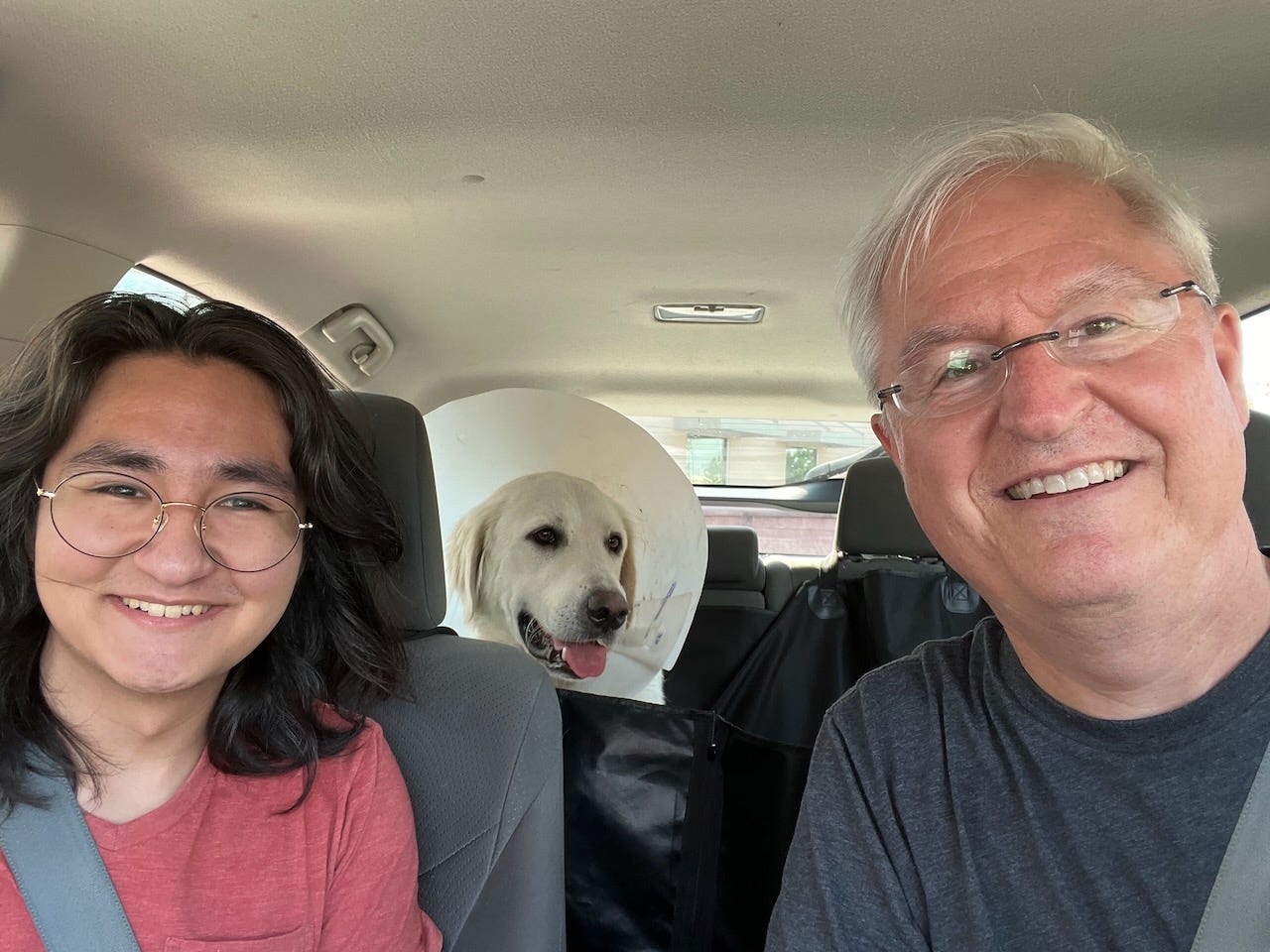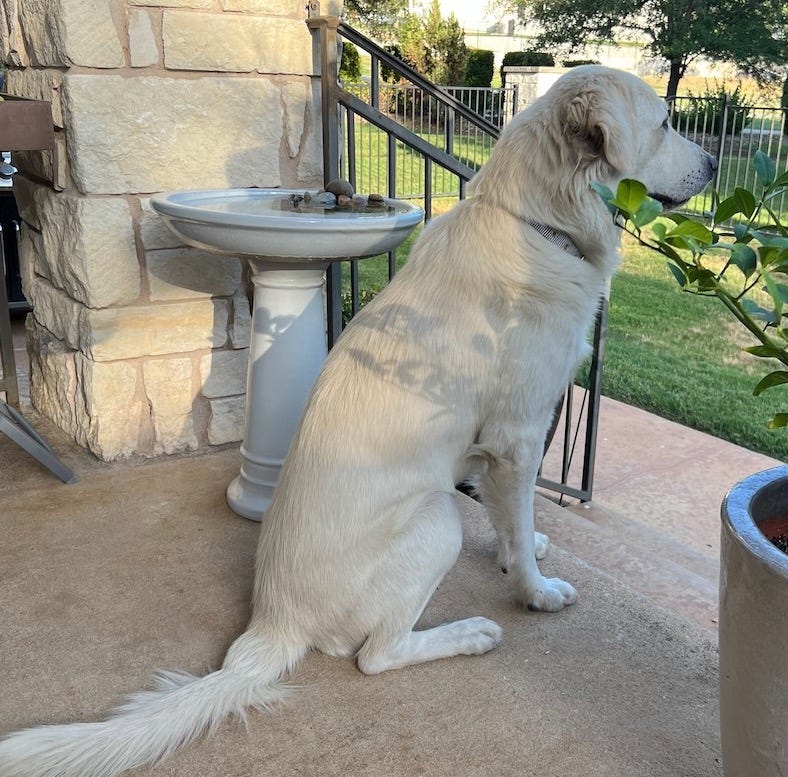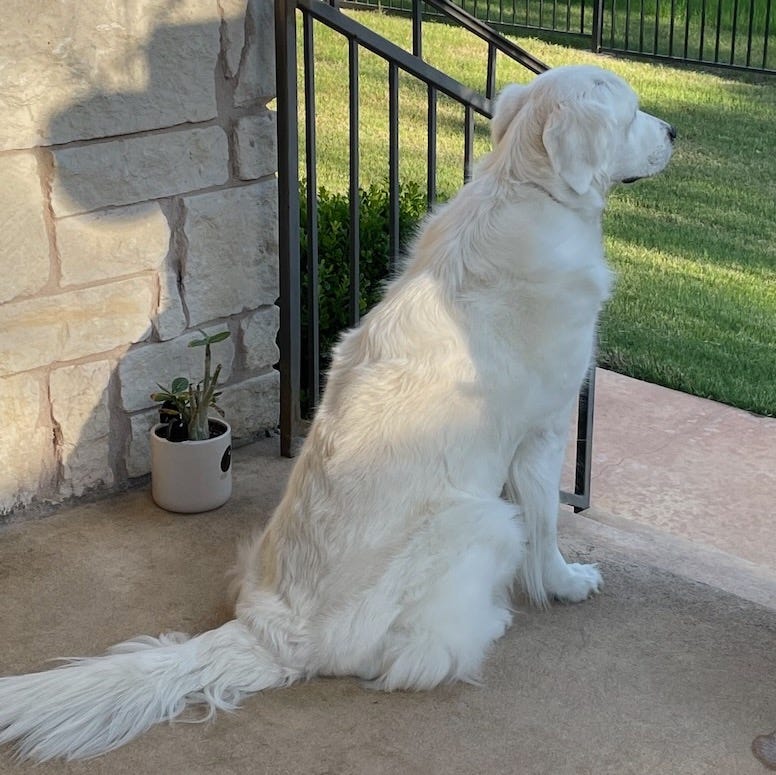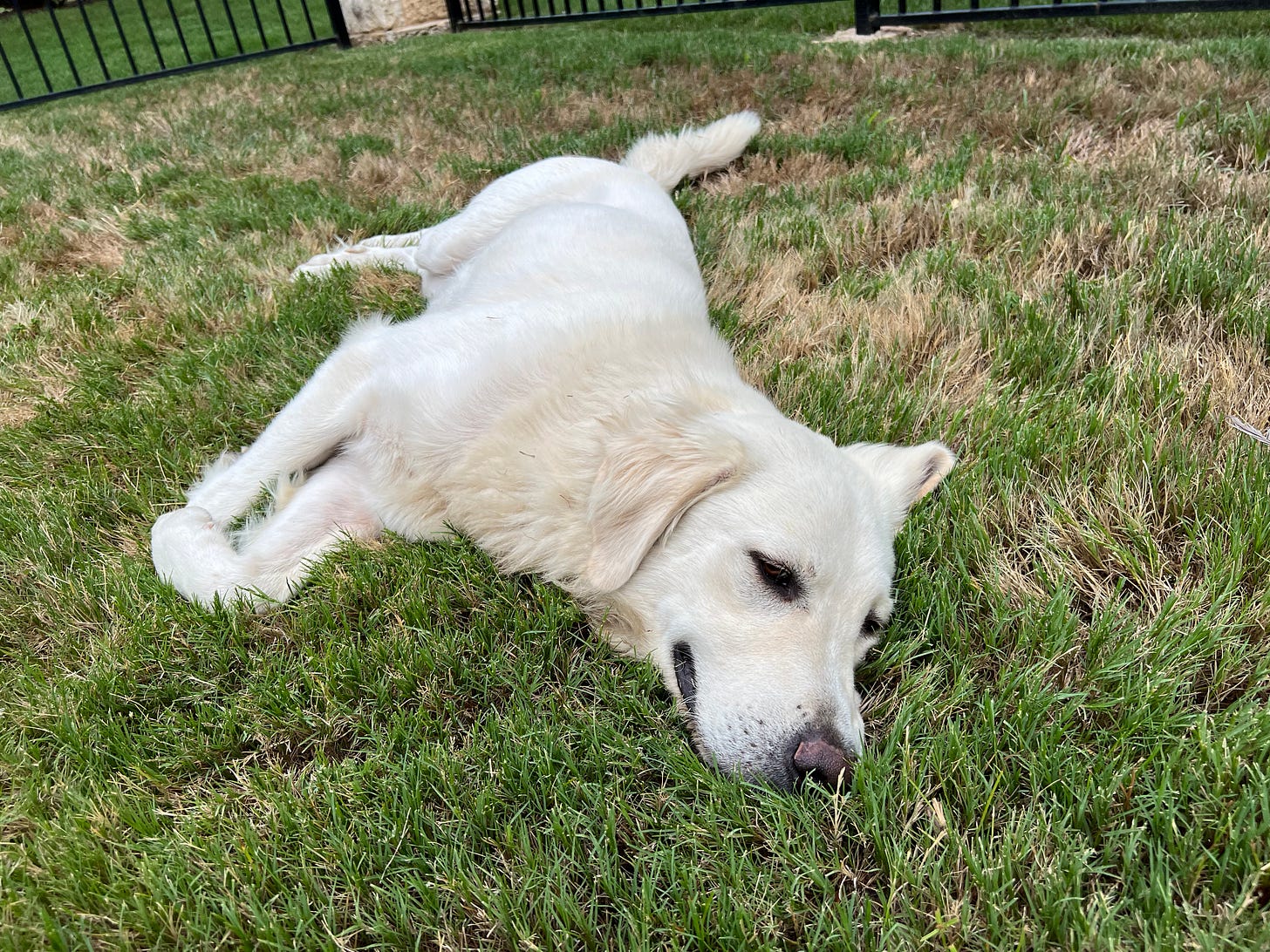The Dog Days of Summer
Here in Austin, Texas we truly are in the Dog Days of Summer. They are called that because they follow the rise of the star Sirius (which is known as the Dog Star), go on from July 3rd to August 11th and are supposedly filled with heat and thunderstorms, as well as a few other things of a less than scientific nature. We’ve been certainly experiencing the heat with many days of 100°+ Fahrenheit weather and while thunderstorms would provide welcome relief, they have been few and far between. Still dogs have been been front and center for our family lately.
This past April 1st, that mythologically unluckiest of days of the year, my wife Jeannie noticed that the belly of our dog Trixie (an 11 year old English Golden Retriever) looked distended. A quick trip to the vet revealed that she had a very common form of cancer that was inoperable. She quickly went downhill and a week later with her death imminent, not wanting to put her through any more, we took her for her very last car ride and visit to the vet. It was one of the hardest things we’ve had to go through. She was a beloved member of our family. If you’ve lost a dog, you know what I mean.
We had no plans to get another dog any time soon for a few reasons. First, we needed time to mourn the loss of Trixie who had been part of our family for as long as our kids can remember. Secondly because with our kids off at college, it was nice for Jeannie and I to be devoid of the responsibility of a dog. Because of Trixie, Jeannie was a member of an English Golden Retriever Facebook group. From time to time, members would post messages about English Goldens at shelters but they were usually in other states. A little over a week ago, there was a post about a two year old male at San Antonio Animal Services which is not a no-kill shelter. I do not normally employ double negatives but it seems wrong to call a shelter a kill shelter. We talked about it and decided that we could foster the dog to avoid it potentially being euthanized. I contacted the shelter only to learn that they don’t foster with people who live outside of the city limits because dogs and cats have to be brought back for shots and other medical services.
We decided we could adopt the dog but really treat him as a foster. We’d keep him here until we found a good home. Jeannie had to work so Sam and I drove to San Antonio to see this dog. He was listed as a Great Pyrenees rather than an English Golden Retriever but this is a common mistake in the US as Americans are not as familiar with English Golden Retrievers which often look almost exactly like Great Pyrenees. The people at Animal Services told us he had been a stray for at least three months but probably longer. He had been paling around a San Antonio neighborhood with another Great Pyrenees and a small dog. Apparently the people in the area had been feeding them until the other Great Pyrenees needed medical attention at which point they called Animal Services. Sam and I spent the required 30 minutes with him in a fenced area then filled out the adoption papers and paid the fee. As luck would have it, they were having some kind of sponsored adoption event so the regular fee of $86 was reduced to just $20. He had been neutered that same morning so they asked us to come back in 90 minutes to give him more time to recover from anesthesia. We got lunch, came back and after waiting for 45 minutes with the engine running to keep the AC on (remember we are in the Dog Days of Summer here), they finally brought him out.
Because of his surgery, he was wearing the cone of shame (actually called an Elizabethan Collar - talk about putting lipstick on a pig), and was acting as if he was still lethargic from the anesthesia. As a result, I had to lift all 70 pounds of him into the back seat of the car. We then began the 90 minute drive back to Austin starting off in San Antonio rush hour traffic. As we slowly left the city, our foster dog was finding it awkward to move around the backseat wearing the cone of shame. He then decided that the best possible place in the car was in the cargo area behind the back seat. He then climbed over the seats which was unfortunate given the hatchback cover was extended. I thought for sure it had been destroyed. A few minutes later, we were able to pull over to find that as soon as he had put pressure on it, it had snapped closed. It was still functional and the damage was quite minimal. Good design, Toyota!
The rest of the drive was quiet. Although it took 15 minutes longer, we avoided the main freeway (the dreaded I-35) instead taking the back way home through rolling tree-filled hills and several small Texas towns. Sam agreed that it was worth the extra time. We serendipitously arrived just as Jeannie did with a brand new bag of dog food. We got him out of the car then led him inside so he could get used to his new, though likely temporary surroundings. After consulting the Internet, Jeannie announced that our foster dog was not an English Golden Retriever and was indeed a Great Pyrenees. Again, they look very similar. Consider these two pictures:
Which is the English Golden Retriever and which is the Great Pyrenees? Read on for the answer to see if you got it right. Despite their very similar outward appearances, they are very different dogs. Golden Retrievers are sporting dogs. They were bred to go fetch and return what was left of some poor bird that had been minding its own business when it was shot out of the sky. They spend a lot of time around people and are expected to learn and respond to commands. They were bred for this purpose. Great Pyrenees, on the other hand, are livestock guard dogs. They work on farms protecting herds of sheep and such. They don’t need to know commands nor spend much time with humans. In fact, they spend nearly all their time with animals who would find praise in being described as dim-witted.
Since he had been a stray, of course Animal Services did not know his name. They decided to give him the shelter name, Beluga. Now while I understand why they chose that name, it nevertheless does not sound like a male dog. We had to call him something and it wasn’t going to be Beluga. My suggestion (Gandalf - as in Gandalf The White) was quickly rejected out of hand. Mia suggested “Teddy” (as in Teddy Bear). This doesn’t scream guard dog either but it’s at least a male name.
Teddy is a very chill dog. Like Trixie, he mostly spends his time looking for new places to sleep. However, unlike Trixie, who was a princess amongst dogs, we quickly saw all the signs of a dog who was clearly not raised inside a home. For example, he didn’t know any commands. When someone knocks at the door, Teddy only looks at it whereas Trixie would run to the door barking at full volume until it was opened to reveal her new best friend. Teddy does not know to beg for food at the table. In this case, his ignorance is our bliss as we can have a complete meal uninterrupted by his wet noise poking at us despite the fact that at 6 inches taller than Trixie, he can rest his chin on our dining room table. Trixie spent every meal under our dining room table and if you walked into the kitchen, you’d find her shadowing you. Teddy doesn’t recognize a dog bed. He doesn’t have any interest in dog toys and only now, more than a week later, has he discovered the delight that is chewing on a tennis ball. He doesn’t know that opening the door means he can go out. He waits for one of us to walk through first.
Teddy has no experience with TV. The first time we turned ours on, with the volume at zero and nothing except the static image of our Apple TV’s menu of icons, Teddy freaked out. He took the most direct route away from the TV he could, over the furniture. We have him now to the point where he will stay in the living room with the TV as long as there is no motion on the screen. As odd as this now sounds for me to write, we thought it might help to find something he’d actually like to watch. It turns out there’s a YouTube channel called “TV for Dogs” which is filled with 8 hour long videos presumably for dogs of people who leave them home all day. The videos are mostly shot in a wooded area with some shelled sunflower seeds on a log that then attracts the local birds and squirrels. They actually take commercial breaks which suggests to me they think people watch too. It’s either that or there are advertisers that think dogs buy cars and book vacations. It was indeed interesting to watch for a few minutes. After that, I could feel my brain cells dying. Teddy had no interest in the flora and the fauna and in fact, it might have only made things worse. Still, he is slowly getting desensitized to it.
I’m a drummer and Teddy’s experience with the TV made me begin to wonder if his level of enthusiasm and appreciation for my drumming might not make him my biggest fan. This had not occurred to Jeannie. It might surprise you that Trixie never even flinched when I played the drums. It just didn’t bother her. So we did a test. I went upstairs and played for a minute while Jeannie recorded Teddy’s reaction with her phone. I think the best way to describe his response would be that of someone locked in a room with a bomb whose large red timer was counting quickly down to zero. He ran back and forth across the living room looking for a way out. He even got up on his back legs and scratched at the glass back door as if the house was on fire. I will have to find a way to desensitize him to this. Either that or my drumming sessions will coincide with his backyard playtime.
Although he had all of his shots and was checked out by a vet at Animal Services, we decided to take Teddy to our vet for a more thorough checkup. This is when we discovered that Teddy also had no idea what it means to be on a leash. He just sat there on the ground. I had to lift him into a standing position but even then as I started to walk away, he didn’t follow. It took some pushing and pulling for him to get the idea. We walked out to the car and after opening the back door and motioning for him to jump in, he made it clear that this whole thing was completely novel. Since we were in a hurry, I once again lifted all 70 pounds of him into the back seat. On the short drive to the vet, I rolled down the back window so he could do the thing that every dog does on a car ride when a window goes down. Once again Teddy proved that he’s not from that side of town.
When we arrived at the vet’s office, Teddy did at least jump out of the back seat on his own. Our appointment was at 4PM but vets are doctors which means we had 30 minutes for Teddy to thoroughly sniff the waiting room before seeing Dr. Winston. Over that half hour, Teddy did seem to be getting the idea of what a leash is and what it means in terms of his behavior. When we finally saw Dr. Winston, Teddy was his chill self. Even when they took him in the back to clip his dew claws, he was so chill that upon their return, the assistants said Teddy was so easy to work with they were only going to charge us half the normal price. Thanks Teddy! Despite being a stray for so long, he’s very healthy. As we left, he was even more clear on his leash responsibilities. I opened the door to the car and while he hesitated for a moment, he then jumped right into the back seat on his own.
While Golden Retrievers are number four on the list of most intelligent dog breeds, Great Pyrenees are not quite so gifted. They come in at number 64. They are also described as stubborn, taking 40 to 80 repetitions to learn a command. It took just two days for Teddy to learn the sit command. I also make him sit and wait every time I feed him. In just a few days he began sitting on his own while waiting for the command to eat. He hasn’t entirely got this down yet as I think he finds the idea of food appearing on a regular schedule so exciting that he just can’t contain himself. We have been crate training him as well. If you’re unfamiliar with this, the idea is that when you are not watching your dog (while you are asleep or away from home), they are in an animal crate of sufficient size. Because dogs don’t want to poop or pee where they sleep, they learn to hold it. Dogs also can’t understand why you are upset that they chewed up your shoes unless you catch them in the act. Being in the crate prevents this from happening. The first night, Teddy whimpered quite a bit before settling down to sleep. The second night he whimpered even more. The third night he didn’t whimper at all. And the fourth night, almost unbelievably, he went into the crate on his own to go to sleep. He loves being outdoors and because of this, he has decided to choose a very small area in the far corner of the backyard to do his business keeping the rest clean for rolling around in. He’s been here for a week and has not had a single accident in the house. That’s odd for a dog that likely didn’t grow up inside a home. He gives himself a massage by rubbing himself against the rods of our metal fence doing one side and then the other. Our backyard gate doesn’t close completely and despite Trixie being a member of a very intelligent breed, it never occurred to her to test the gate. It took Teddy a day to figure out he could push it open. Now it’s got a bungie cord to keep it shut. He has also thwarted all of our attempts to keep in from going upstairs (which is carpeted and will not be open to him until he’s had a bath after he gets his stitches out). He finally bypassed the barrier we created completely after watching Sam avoid it. In short, Teddy seems to be a fast learner, nothing like the slow and stubborn profile of a Great Pyrenees.
This has led us to believe that he’s almost certainly a mix. We don’t know what he’s mixed with, but it’s something smarter than a Great Pyrenees. I’ve ordered a Doggie DNA kit so we will know in a few weeks. Teddy also rarely barks. In fact for the first few days he didn’t bark at all. Over the last week he’s barked just a few times and even then it’s two to four barks low in both volume and pitch. When out in the backyard, he doesn’t even bark at people or other dogs that go by. Trixie would never allow such an opportunity to go to waste. I don’t know why he’s not much of a barker (so far) but it’s certainly appreciated.
Over the past week since he arrived, we have all been bonding with Teddy, me especially. He whimpers when we leave and he’s very happy when we return. He regularly comes to us to have his ears or head scratched. In most cases, I must not do it long enough because when I take my hand away, he pushes his nose under my hand to remind me that he didn’t tell me I was done. Since Great Pyrenees are from France and July 14th is both Independence Day (Bastille Day) there and the day we adopted Teddy, we have decided that will be his birthday.
And now for the moment you’ve been waiting for. In the pictures above, the first picture is Teddy, a Great Pyrenees mix while the second is Trixie, an English Golden Retriever. Did you get it right?
Teddy has gone from street dog to the good life almost overnight. It warms our hearts to save his life and make him a member of our family. He does, however, still have to get used to my drumming.






As a herding dog breeder I'm familiar with the Great Pyrenees and Kuvasz. However, the English Golden Retriever I'm not as familiar with and was more than happy to learn more. It was great that Trixie was a beloved family member for all those years. Letting a dog go to the Rainbow Bridge is as difficult or even more painful than grieving for a human. The dog bond is often equal to or stronger than the human bond. A dog forgives their owners nearly 99.99% of the time whereas humans can be unpredictable. So, I literally breakdown when one of my dogs reaches that point. I'm happy that Teddy is starting to fit in nicely and fill the void. No, I didn't guess correctly when it came to breed identification. As for the drumming, dog's hearing changes over time. Dogs that weren't sensitive to fireworks at an earlier age now have a reaction. I would like to hear Teddy's progression with your drumming practice sessions. Sometimes a safe place helps. One suggestion would be to have someone take Teddy for a ride in the car while you practice. I did that during Indiana's 4th of July with my dogs because literally everyone sets off Disneyland scale fireworks in Northwest Indiana. The road noise does a good job of filtering out the booms from the freeways.
The first time I heard the term "rainbow bridge" was somewhat recent and I wondered where it came from so I looked it up. It turns out that it's from a poem written I believe in the 60s or 70s. People latched on to "rainbow bridge" as a metaphor for the death of a pet but it turns out, that's not quite right. The idea is that when your pet dies, it goes to this great field where it can run and play with other pets, it has plenty to eat (though why that would be necessary escapes me) and there it waits for you. Once you pass, the two of you together cross the rainbow bridge into the permanent afterlife.
I've ordered an Embark Dog DNA kit and sent it off so in a few weeks we should know what breeds Teddy has in him. I sincerely doubt he's a purebred Great Pyrenees.
While we didn't get Teddy to fill the void left by Trixie, he's a welcome addition to our family for sure.
Dog's even with in the same breed (and probably from the same parents) can have such different personalities. I hadn't considered that before. Teddy is very different from Trixie. Trixie was exposed to the drums at about 6 years old. Teddy is only 2 years old so that could be a factor. I've got some ideas about how to desensitize him to it. He's clearly more easily spooked probably due to simply not being an indoor dog up until now.